It seems like yesterday that I first wrote about the five wireless inventions that defined 5G NR. At the time, 5G was not yet deployed. Today, however, we are in the midst of rapidly expanding 5G’s global footprint. To date, over 70 mobile operators have already deployed commercial 5G services around the world, and we expect many more to do so by the end of this year.
5G NR Release 15 — establishing the 5G foundation
Our vision for 5G was a unified connectivity fabric supporting diverse devices, services, spectrum, and deployments. To realize this goal, we contributed core inventions to the first 5G standard — 3GPP Release 15, which established the technology foundation for the 5G evolution to come in this decade.

Before we get into Release 16, let me first give a few examples that explain why our Release 15 inventions are so vital to realizing the full potential of 5G. For instance, the flexible slot-based framework opens the door to efficient multiplexing of different 5G services (i.e., enhanced mobile broadband, mission-critical services, and massive IoT). The flexible OFDM numerology allows for the same 5G NR design to scale to different and new spectrum bands (i.e., from sub-1 GHz to 60+ GHz), and mobile mmWave greatly expands network capacity needed for 5G’s expansion and making extreme speeds possible. To better illustrate how these Release 15 inventions are central to the 5G system, we can use the following transportation system analogies. Click on the GIF below to watch the full animation.
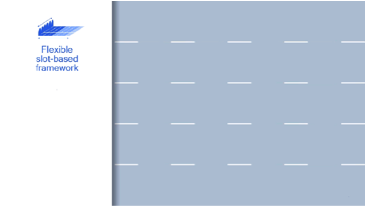
5G NR Release 16 — driving the 5G expansion
Just a couple weeks ago, 3GPP achieved another important milestone — the completion of Release 16 specifications, marking the beginning of a new chapter in 5G evolution. Release 16 is a concerted effort to deliver further enhancements to the 5G technology foundations (i.e., coverage, mobility, power, reliability, etc.) and expand 5G’s reach to new use cases, spectrum bands, and vertical industries. It is an ambitious set of technical projects, but let me distill them into six key invention areas — not in any order — that are core to continued 5G evolution.
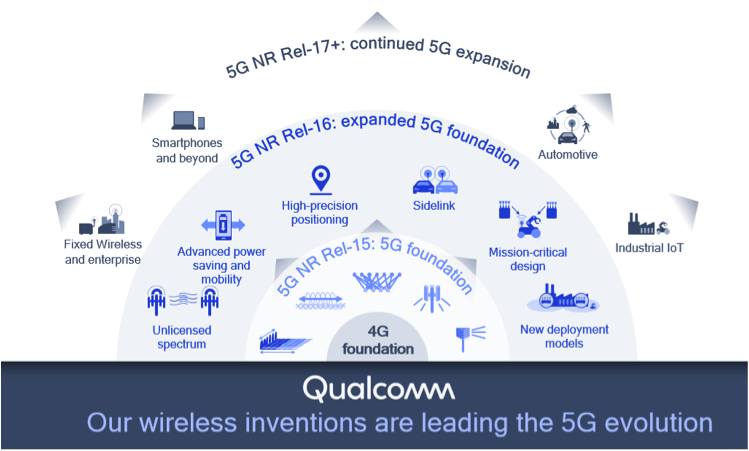
Invention area #1: Unlicensed spectrum
Expanding 5G to operate in all spectrum types and bands is a key aspect of our 5G vision, which will not only bring more capacity but also more flexible deployments. At Qualcomm Technologies, we have been pioneering cellular technologies operating in unlicensed spectrum for almost a decade now. Release 16 adds support for unlicensed spectrum for 5G NR (NR-U) that includes two modes of operation: license assisted access (LAA) and a standalone deployment option that does not require any licensed spectrum. The LAA mode allows mobile operators to tap into unlicensed spectrum to boost 5G bandwidth, building upon what they are already doing with LTE LAA. The standalone NR-U mode does not require licensed spectrum, which brings 5G benefits to a broader ecosystem, including mobile operators, service providers, wireless ISPs, and 5G private network operators. In addition, NR-U can also be used to deploy 5G in the new 6 GHz band. Looking forward, NR-U will serve as the basis for future spectrum innovations such as supporting the unlicensed 60 GHz band that is targeting Release 17.
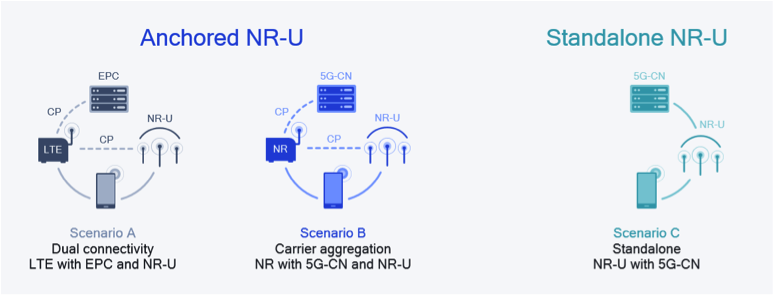
Invention area #2: Advanced power saving and mobility
As most 5G mobile devices are battery powered, it is imperative to push the power efficiency envelope further. In Release 16, we drove many new system power saving features, including (i) a new wakeup signal (WUS) that minimizes control signaling monitoring in low power mode, (ii) a streamlined random access procedure (RACH) that also has broader benefits, and (iii) low-power carrier aggregation control that efficiently powers down secondary carriers when they are not in use. Mobility is another vector that we have been working to further enhance in Release 16. For instance, device-driven conditional handover, early measurement reporting, and dual-connectivity MCG (master cell group) failure recovery can reduce handover interruption time (for close to 0ms handover) to further improve device mobility performance.
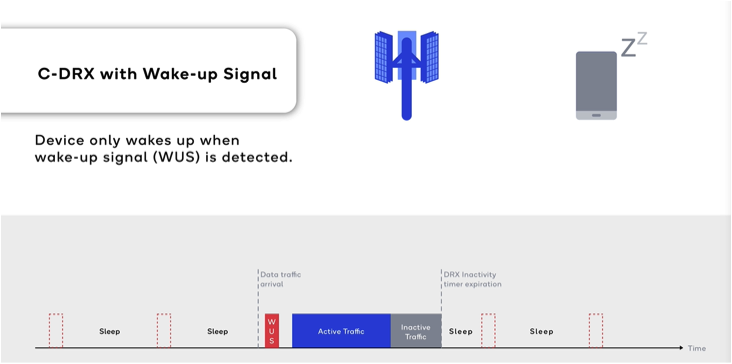
Invention area #3: High-precision positioning
Accurate device positioning is a key enabler for many vertical applications, such as public safety and indoor navigation. The benefit of cellular-based positioning, which complements existing GNSS systems, is that it works well outdoors and indoors. We have long been a pioneer in location technology and this continues with innovations that enable Release 16 positioning. Release 16 supports multi-/single-cell and device-based positioning, defining a new positioning reference signal (PRS) used by various 5G positioning techniques such as roundtrip time (RTT), angle of arrival/departure (AoA/AoD), and time difference of arrival (TDOA). Roundtrip time (RTT) based positioning removes the requirement of tight network timing synchronization across nodes (as needed in legacy techniques such as TDOA) and offers additional flexibility in network deployment and maintenance. These techniques are designed to meet initial 5G requirements of 3 and 10 meters for indoor and outdoor use cases, respectively. In Release 17, precise indoor positioning functionality will bring sub-meter accuracy for industrial IoT use cases.
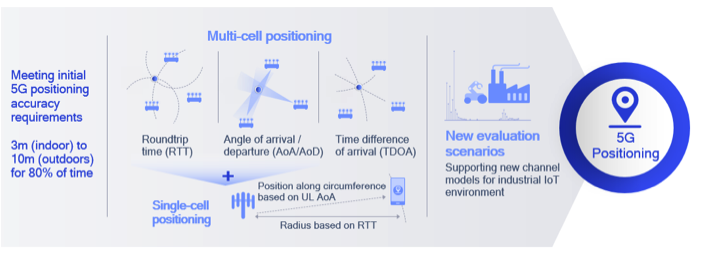
Invention area #4: Sidelink
Another key Release 16 invention area is the NR-based sidelink for cellular-vehicle-to-everything (C-V2X). Building on our heritage of driving Release 14/15 C-V2X, which provided basic safety, we continue to drive Release 16 to offer major enhancements to the sidelink, supporting advanced applications such as coordinated driving and sensor sharing. It brings several improvements in the form of higher throughput, lower latency, distance-based reliable multicast, distributed synchronization and unified QoS control — all are expected to enhance autonomous and semi-autonomous driving in terms of efficiency and safety. The NR-based sidelink in Release 16 is another foundational technology that can be used for a wide range of additional future use cases, such as public safety communications and commercial applications.
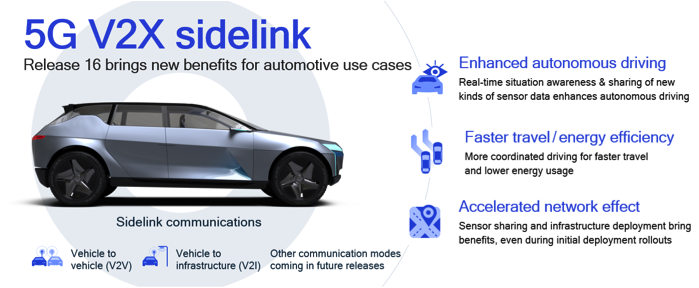
Invention area #5: Mission-critical design
5G NR in Release 16 added a collection of new features that can elevate 5G system capabilities for mission-critical use cases, such as Industry 4.0 factory automation. One objective is for 5G NR to meet more stringent reliability requirements (i.e., up to 99.9999%), while maintaining millisecond level latency. Coordinated multi-point (CoMP) is one of the key technology enablers, which utilizes multiple transmission and reception points (multi-TRP) to create spatial diversity with redundant communication paths. In addition, our Release 16 inventions further improved service multiplexing, allowing mission-critical and mobile broadband traffic to more efficiently coexist in the common 5G NR framework and supporting enhanced features like logical channel prioritization and downlink and uplink pre-emption.
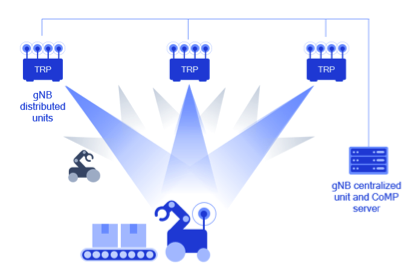
Invention area #6: New deployment models
To meet the 5G vision of supporting diverse deployments, Release 16 introduced several new capabilities that broadened the reach of 5G. The expanded support for non-public network (NPN) will help accelerate 5G private network deployments, such as industrial IoT and enterprise networks. Time-sensitive networking (TSN) allows 5G networks to deliver services with stringent synchronization and latency requirements that are critical to many industrial IoT use cases (e.g., machine control). New interference measurement and mitigation techniques (such as RIM/CLI) enable robust deployments and set the stage for future dynamic TDD operation with base station-to-base station and mobile-to-mobile interference mitigation. Integrated access and backhaul (IAB) allows mmWave base stations to be used as both wireless access and backhaul, thereby eliminating the need for new fiber deployments when densifying the network. Lastly, Release 16 also supports eMTC and NB-IoT deployed in 5G spectrum and managed by a 5G core network for 5G massive IoT services.

What’s next?
3GPP Release 16 is a wrap, but our work driving 5G technology evolution to fully realize the potential of this latest G doesn’t stop here. We are already working with the mobile ecosystem on Release 17 projects and are researching advanced technologies for Release 18 and beyond. I am very excited about our 5G future. There is a vast amount of 5G innovation in the pipeline and it will fuel continued breakthroughs in this decade and beyond.
Learn more…
For more detailed information on 3GPP Release 16 projects, sign up for our webinar on 7/7, and check out our advanced 5G technology demo YouTube playlist. Also, be sure to sign up for our wireless technologies newsletter to stay up to date as we accelerate into our 5G future.

